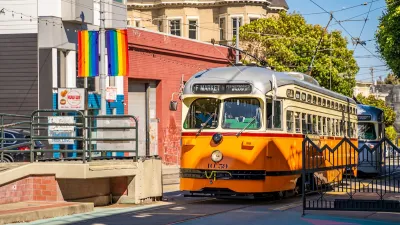The SFMTA is improving service at off-peak hours and on weekends to accommodate new travel patterns that rely less on weekday commuters. Ridership has increased accordingly.

The San Francisco Municipal Transportation Agency (SFMTA) transit system saw its highest ridership since the start of the Covid-19 pandemic this September, reports James Salazar for the San Francisco Examiner.
“The transit system averaged more weekday riders in September — 521,050, or about 74% of levels from the same month in 2019 — than any month since February 2020, crossing the threshold of 500,000 average weekday boardings for the first time since then, according to a newly published San Francisco Municipal Transportation Agency report.” Weekend boardings were at 92 percent of pre-pandemic levels, Salazar adds.
The agency acknowledges that the bulk of trips has shifted from office commuters to off-peak travelers, prompting SFMTA to make changes to routes to accommodate new travel patterns. “The agency rerouted the 22 Fillmore — the monthly ridership of which was at 122% of pre-pandemic levels — to serve additional parts of the emerging Mission Bay neighborhood. SFMTA also built transit-only lanes on 17th street, which Tumlin said helped the bus line’s speed and reliability.” According to SFMTA, subway delays have decreased by 50 percent since before the pandemic.
The system is refocusing its efforts on serving attendees to music festivals and other events in San Francisco, weekends that often see spikes transit ridership. According to SFMTA director Jeffrey Tumlin, “Chase Center event tickets doubling as Muni passes has driven ridership to the arena and its surrounding neighborhoods.”
FULL STORY: Muni crosses half-million monthly rider average for first time since 2020

Study: Maui’s Plan to Convert Vacation Rentals to Long-Term Housing Could Cause Nearly $1 Billion Economic Loss
The plan would reduce visitor accommodation by 25,% resulting in 1,900 jobs lost.

Alabama: Trump Terminates Settlements for Black Communities Harmed By Raw Sewage
Trump deemed the landmark civil rights agreement “illegal DEI and environmental justice policy.”

Why Should We Subsidize Public Transportation?
Many public transit agencies face financial stress due to rising costs, declining fare revenue, and declining subsidies. Transit advocates must provide a strong business case for increasing public transit funding.

Paris Bike Boom Leads to Steep Drop in Air Pollution
The French city’s air quality has improved dramatically in the past 20 years, coinciding with a growth in cycling.

Why Housing Costs More to Build in California Than in Texas
Hard costs like labor and materials combined with ‘soft’ costs such as permitting make building in the San Francisco Bay Area almost three times as costly as in Texas cities.

San Diego County Sees a Rise in Urban Coyotes
San Diego County experiences a rise in urban coyotes, as sightings become prevalent throughout its urban neighbourhoods and surrounding areas.
Urban Design for Planners 1: Software Tools
This six-course series explores essential urban design concepts using open source software and equips planners with the tools they need to participate fully in the urban design process.
Planning for Universal Design
Learn the tools for implementing Universal Design in planning regulations.
Smith Gee Studio
Alamo Area Metropolitan Planning Organization
City of Santa Clarita
Institute for Housing and Urban Development Studies (IHS)
City of Grandview
Harvard GSD Executive Education
Toledo-Lucas County Plan Commissions
Salt Lake City
NYU Wagner Graduate School of Public Service





























